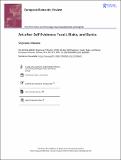Art after self evidence : Fuseli, Blake, and Banks
Abstract
This article examines artworks by Henry Fuseli, William Blake, and Thomas Banks in relation to changing notions of “self evidence” at the turn of the nineteenth century. It considers how models of artistic neoclassicism and scientific experimental procedures shared an investment in the evidentiary authority of an idealized male body. Exploring the gendered and racial hierarchies operative in such an ideal, this article also charts its unraveling.
Citation
O'Rourke , S 2022 , ' Art after self evidence : Fuseli, Blake, and Banks ' , European Romantic Review , vol. 33 , no. 4 , pp. 497-513 . https://doi.org/10.1080/10509585.2022.2090699
Publication
European Romantic Review
Status
Peer reviewed
ISSN
1050-9585Type
Journal article
Collections
Items in the St Andrews Research Repository are protected by copyright, with all rights reserved, unless otherwise indicated.

